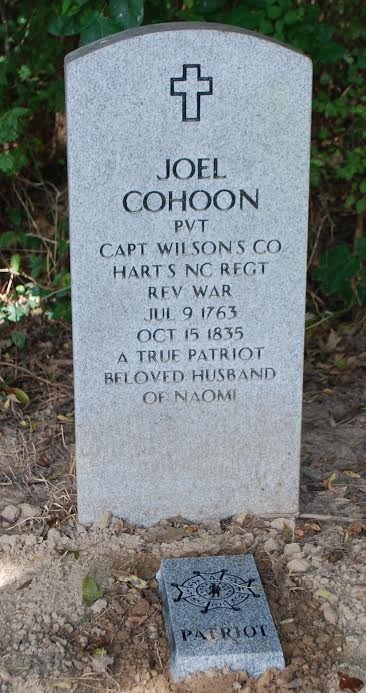Joel COHOON/CALHOUN
SAR Patriot #:
P-334328
The following information was assembled from numerous sources and cannot be used directly as proof of Qualifying Service or Lineage.
It is considered a research aid and is intended to assist in locating sources that can be used as proof.
State of Service: NC
Qualifying Service: Private
DAR #: A018296
Birth: 09 Jul 1763 / Edgecombe / NC
Death: 18 Oct 1835 / Trigg / KY
Qualifying Service Description:
- Private, Capt Wilson's Company, Colonel Crain's Regiment, NC
- Military service in the Rev. War; served most of his first tour of duty with Gen Butler in the area of Ramsour's Mill
- After enlisting at Nashville Court House he marched to High Rock Ford. This is where Gen.Nathanael Greene assembled his army after the Guilford Courthouse battle
- He enlisted as line soldier about 1776 in Edgecombe County, NC. His application says that he and his father were living in Edgecombe County at the time of his enlistment
Additional References:
Pension: S*W8576
Spouse: Naomi Futrell
Children: Charity; David Green; Josiah;
Members Who Share This Ancestor
| Date Approved | Society | ACN | SAR Member Info | Lineage via Child | View Application Detail | |
|---|---|---|---|---|---|---|
| 2015-10-27 | CA | 65827 | William Samuel Bradley (180859) | Charity | ||
| 2017-02-10 | FL | 73125 | Robert Leon Parrish (201366) | Archibald | ||
| 2020-02-14 | DC | 79019 | Jerry Don Lowery (214575) | David | ||
| 2020-10-30 | TX | 92828 | Charles Michael Morgan (210055) | Josiah | ||
| 2020-10-30 | TX | 92829 | Chance Everett Morgan (210056) | Josiah |
Location:
/ Trigg / KY / USA
Find A Grave Cemetery #:
Marker Type:
SAR
SAR Grave Dedication Date:
12 Sep 2015
Comments:
- Find-a-Grave cites No location information available
- Photo by permission: Geoff Baggett, Kentucky Society SAR.Markers placed in cemetery; exact location of burial site unknown
Directions to Cemetery / Gravesite:
